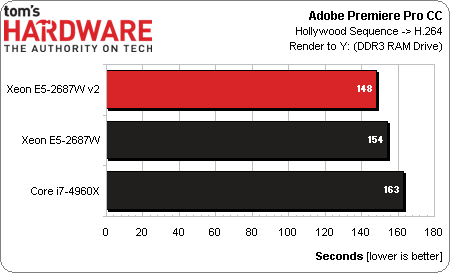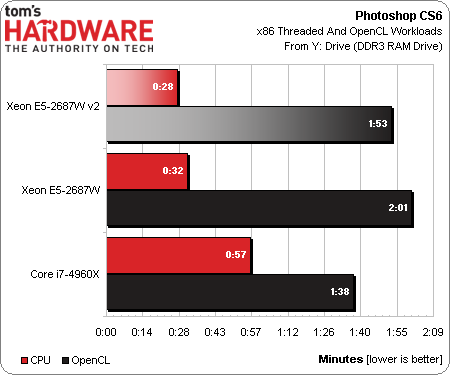Intel Xeon E5-2600 v2: More Cores, Cache, And Better Efficiency
Intel recently launched its Xeon E5-2600 v2 CPU, based on the Ivy Bridge-EP architecture. We got a couple of workstation-specific -2687W v2 processors with eight cores and 25 MB of L3 cache each, and are comparing them to previous-generation -2687Ws.
Results: Adobe CC
Today’s story forces us to consider one consequence of a growing emphasis on heterogeneous computing. As we offload parallel tasks to on-die or discrete graphics engines, there’s less for many-core CPUs to do.
Although it’s tempting to look at our results and assume that CUDA acceleration is helping normalize performance as the Quadro FX 1800 becomes a bottleneck, Nvidia’s older pro board isn’t on Adobe’s list of supported add-in cards. We double-checked and verified that there is no GPU activity during the test; it’s CPU-only.
We also know from past stories that our Premiere Pro rendering tasks do utilize many cores. It’s probable that our benchmark isn’t complex enough to fully demonstrate what two eight-core processors can do. The Paladin test we used previously was intensive, but designed for Premiere Pro CS5. Two generations later, our Hollywood sequence just isn’t the same.
The same goes for After Effects, which can be accelerated by CUDA/OpenCL-compatible cards, but doesn’t natively support our Quadro FX 1800. In the past, this test was actually bottlenecked by three QuickTime clips, which couldn’t be threaded. We replaced those with PNG sequences to address that limitation. Now we see 100% utilization, though scaling is not evident based on host processor performance.
Finally, by the time we get to Photoshop CC, OpenCL support is enabled on our Quadro FX 1800. Interestingly, though, backing the Nvidia card with more x86 cores doesn’t help improve the performance of accelerated filters. In fact, the opposite is true: both dual-CPU workstations are slower than the Core i7-based box.
The situation reverses when we execute a series of threaded filters. The two Xeon E5-2687W v2s do their job in half the time of one Core i7-4960X. Chalk this up as an application where it pays to know where to spend money on hardware. Certain filters are going to push mainstream CPUs with high clock rates. Others will favor massively parallel configurations. And a few more are optimized for OpenCL.
Get Tom's Hardware's best news and in-depth reviews, straight to your inbox.
Current page: Results: Adobe CC
Prev Page Results: Sandra 2014 And 3DMark Next Page Results: Media Encoding-
GL1zdA1 Does this mean, that the 12-core variant with 2 memory controllers will be a NUMA CPU, with cores having different latencies when accessing memory depending on which MC is near them?Reply -
Draven35 The Maya playblast test, as far as I can tell, is very single-threaded, just like the other 3d application preview tests I (we) use. This means it favors clock speed over memory bandwidth.Reply
The Maya render test seems to be missing O.o
-
Cryio Thank you Tom's for this Intel Server CPU. I sure hope you'll make a review of AMD's upcoming 16 core Steamroller server CPUReply -
voltagetoe If you've got 3ds max, why don't you use something more serious/advanced like Mental Ray ? The default renderer tech represent distant past like year 1995.Reply -
lockhrt999 "Our playblast animation in Maya 2014 confounds us."@canjelini : Apart from rendering, most of tools in Maya are single threaded(most of the functionality has stayed same for this two decades old software). So benchmarking maya playblast is as identical as itunes encode benchmarking.Reply -
daglesj I love Xeon machines. As they are not mainstream you can usually pick up crazy spec Xeon workstations for next to nothing just a few years after they were going for $3000. They make damn good workhorses.Reply -
InvalidError @GL1zdA1: the ring-bus already means every core has different latency accessing any given memory controller.Memory controller latency is not as much of a problem with massively threaded applications on a multi-threaded CPU since there is still plenty of other work that can be done while a few threads are stalled on IO/data. Games and most mainstream applications have 1-2 performance-critical threads and the remainder of their 30-150 other threads are mostly non-critical automatic threading from libraries, application frameworks and various background or housekeeping stuff.Reply -
mapesdhs Small note, one can of course manually add the Quadro FX 1800 to the relevant fileReply
(raytracer_supported_cards.txt) in the appropriate Adobe folder and it will work just
fine for CUDA, though of course it's not a card anyone who wants decent CUDA
performance with Adobe apps should use (one or more GTX 580 3GB or 780Ti is best).
Also, hate to say it but showing results for using the card with OpenCL but not
showing what happens to the relevant test times when the 1800 is used for CUDA
is a bit odd...
Ian.
PS. I see the messed-up forum posting problems are back again (text all squashed
up, have to edit on the UK site to fix the layout). Really, it's been months now, is
anyone working on it?



